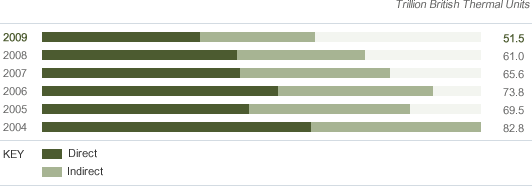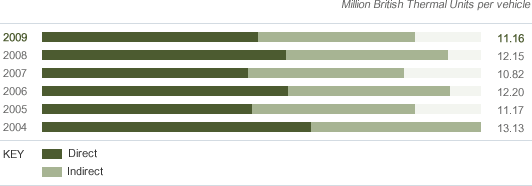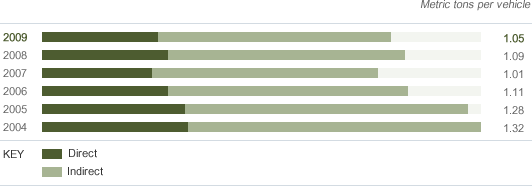Toolbox
Operational Energy Use and CO2 Emissions
Data On This Page
A. Worldwide Facility Energy Consumption

| 2004 | 2005 | 2006 | 2007 | 2008 | 2009 | |
|---|---|---|---|---|---|---|
| Total | 82.8 | 69.5 | 73.8 | 65.6 | 61.0 | 51.5 |
| Direct | 50.8 | 39.0 | 44.6 | 37.3 | 36.7 | 29.8 |
| Indirect | 32.0 | 30.5 | 29.2 | 28.3 | 24.3 | 21.7 |
Data have been adjusted to account for facilities that were closed, sold or new. This data does not include Automotive Components Holdings (ACH) facilities.
We reduced worldwide facility energy consumption for the fourth year in a row. These reductions were accomplished through a wide range of energy-efficiency projects and due to the drop in production. For more information, please see Operational Energy and Greenhouse Gas Emissions.
- Data managed through the Global Emissions Manager database
In This Report:
B. Worldwide Facility Energy Consumption Per Vehicle

| 2004 | 2005 | 2006 | 2007 | 2008 | 2009 | |
|---|---|---|---|---|---|---|
| Total | 13.13 | 11.17 | 12.20 | 10.82 | 12.15 | 11.16 |
| BTUs/vehicle direct | 8.06 | 6.27 | 7.37 | 6.15 | 7.31 | 6.45 |
| BTUs/vehicle indirect | 5.07 | 4.90 | 4.83 | 4.67 | 4.84 | 4.71 |
These data do not include Automotive Components Holding facilities.
Energy consumption per vehicle divides energy used by the number of vehicles produced. Averaging energy consumption per vehicles produced yields a somewhat imperfect indicator of production efficiency. When the number of vehicles produced declines, as it has since 2000, per-vehicle energy use tends to rise, because a portion of the resources used by a facility is required for base facility operations, regardless of the number of vehicles produced.
We believe that the long-term trend of declining per-vehicle energy use emissions indicate that more efficient production since 2000 is offsetting the tendency of these indicators to rise during periods of declining production. This interpretation is reinforced by our Energy Efficiency Index, which focuses on production energy efficiency and which has been steadily improving. Our Energy Efficiency Index target also has the effect of driving reductions in CO2 emissions.
- Data managed through the Global Emissions Manager database
In This Report:
C. Worldwide Facility CO2 Emissions

| 2004 | 2005 | 2006 | 2007 | 2008 | 2009 | |
|---|---|---|---|---|---|---|
| Total | 8.3 | 8.0 | 6.7 | 6.1 | 5.4 | 4.9 |
| Direct | 2.8 | 2.7 | 2.3 | 2.0 | 1.9 | 1.6 |
| Indirect | 5.5 | 5.3 | 4.4 | 4.1 | 3.5 | 3.3 |
The data have been adjusted to account for facilities that were closed, sold or new. The data does not include Automotive Components Holdings facilities.
- Sixty-one percent of Ford's global facility GHG emissions are third-party verified. All of Ford's North American GHG emissions data since 1998 are externally verified by The Financial Industry Regulatory Authority, the auditors of the NASDAQ stock exchange, as part of membership in the Chicago Climate Exchange. In addition, all of our European facilities impacted by the mandatory EU Trading Scheme are third-party verified.
We reduced worldwide facility CO2 emissions for the fifth year in a row. These reductions were accomplished through a wide range of energy efficiency projects. For more information, please see Operational Energy and Greenhouse Gas Emissions.
- Third-party verified (North America and EU)1
- Reported to regulatory authorities (EU). Voluntarily reported to registry or other authority (U.S., Canada, Mexico, Australia, Philippines, Chongqing, China).
In This Report:
D. Worldwide Facility CO2 Emissions Per Vehicle

| 2004 | 2005 | 2006 | 2007 | 2008 | 2009 | |
|---|---|---|---|---|---|---|
| Total | 1.32 | 1.28 | 1.11 | 1.01 | 1.09 | 1.05 |
| Direct | 0.44 | 0.43 | 0.38 | 0.33 | 0.38 | 0.35 |
| Indirect | 0.88 | 0.85 | 0.72 | 0.68 | 0.71 | 0.70 |
These data do not include Automotive Components Holding facilities.
CO2 emissions per vehicle divides CO2 emitted by the number of vehicles produced. Averaging CO2 emissions by the number of vehicles produced yields a somewhat imperfect indicator of production efficiency. When the number of vehicles produced declines, as it has since 2000, per-vehicle energy use tends to rise, because a portion of the resources used by a facility is required for base facility operations, regardless of the number of vehicles produced.
We believe that the long-term trend of declining per-vehicle CO2 emissions indicate that more efficient production since 2000 is offsetting the tendency of these indicators to rise during periods of declining production. This interpretation is reinforced by our Energy Efficiency Index, which focuses on production energy efficiency and which has been steadily improving. Our Energy Efficiency Index target also has the effect of driving reductions in CO2 emissions.
- Data managed through the Global Emissions Manager database
In This Report:
E. Energy Efficiency Index

| 2004 | 2005 | 2006 | 2007 | 2008 | 2009 |
|---|---|---|---|---|---|
| 87.8 | 83.4 | 78.4 | 74.4 | 69.9 | 65.3 |
The Index, which covers energy use in North America, is "normalized" based on an engineering calculation that adjusts for typical variances in weather and vehicle production. The Index was set at 100 for the year 2000 to simplify tracking against our target of 3 percent improvement in energy efficiency.
We have improved our Energy Efficiency Index score every year since we began calculating this index in 2000. We have achieved these results through a wide variety of energy-efficiency improvements. For more information, please see Operational Energy and Greenhouse Gas Emissions.